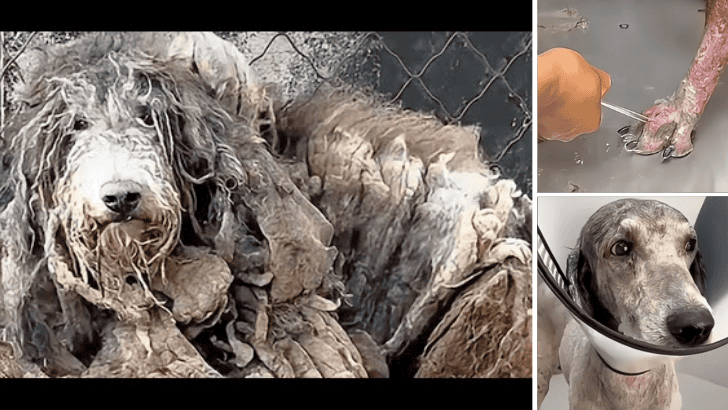In a heartbreaking case of long-term neglect, a dog trapped in a small iron cage for four years has finally been rescued after years of suffering in silence. The animal had been surviving solely thanks to the kindness of nearby neighbors who occasionally tossed scraps of food his way. His owner had all but abandoned him—offering neither food, nor affection, nor basic care. His living conditions were so dire that his fur had hardened into armor made of feces and urine, caked onto his skin after years without cleaning.

The story came to light when a passerby noticed the animal crouched in the corner of a filthy enclosure and decided to alert a local animal rescuer. This rescuer, a man known for his dedication and experience—having saved over 300 dogs in the past—responded immediately. What he found was worse than anything he had anticipated.
When he arrived, the smell was overwhelming. The cage was rusted and covered in layers of waste. The dog himself was unrecognizable beneath the filth. Through conversations with nearby residents, the rescuer learned more about the dog’s miserable life. The owner was a known alcoholic who lived alone and routinely abused the dog while intoxicated. The neighbors confirmed that the dog hadn’t left the cage in years—not even for a walk or fresh air.

Deeply moved and angered by the situation, the rescuer confronted the dog’s owner. It took a long and emotionally charged negotiation before the man finally agreed to give up the dog—in exchange for money. As frustrating as the arrangement was, the rescuer knew that the dog’s freedom mattered more than the principle.
But freeing the dog was just the beginning.
When the cage door opened, the dog didn’t move. He was too afraid to leave. After years of confinement, the small, grimy space had become his only sense of security. The rescuer gently attached a leash and tried to coax him out, but the dog panicked. In a moment of fear, he bolted right back into the cage, slipping the leash off in the process. It was as if he had forgotten what freedom even was. Realizing the dog would not come out on his own, the rescuer climbed back into the cage, carefully navigating the filth to retrieve him once more.
That night, the man brought the dog home. Despite the late hour, he began the long and delicate process of cleaning the dog’s fur. Using electric clippers and scissors, he shaved away layers of matted hair, uncovering the dog’s frail body underneath. The process took over an hour. As the weight of the hardened fur fell away, something remarkable happened—a small, weary smile formed on the dog’s face, a flicker of relief finally breaking through.
But the deeper the rescuer shaved, the more alarming the discoveries became.
The dog’s hind legs were severely infected, covered in raw wounds and crawling with maggots. The infection had become so advanced that, had the rescue been delayed even a little longer, amputation might have been necessary. The pads of his feet had also been eaten away, leaving exposed tissue and open holes. The rescuer, used to dealing with extreme cases, did not hesitate. He carefully cleaned the wounds, removed as many maggots as he could, and administered temporary treatment to keep the dog stable through the night.
The next morning, the dog was rushed to a veterinary hospital for full evaluation. After blood tests, X-rays, and an overall assessment, the diagnosis was sobering. The dog was running a high fever, had bloody stools, and was suffering from multiple infections. His condition was critical, and the veterinary staff began immediate intervention. Over the coming days, he was put on IV fluids, antibiotics, daily wound cleaning, and pain management. He remained hospitalized under close supervision, gradually gaining strength.
By the fifth day, there were signs of improvement. The dog, once too weak to stand, began to show interest in food again. On the tenth day, he had his stitches removed, and by day fifteen, he was finally stable enough to be discharged. His physical indicators had normalized, and his immune system was slowly bouncing back.
Now back in a safe and clean environment, the dog is continuing his recovery. He is still shy, still cautious, but finally free. He no longer lives in fear of abuse or in the prison of rusted bars and hardened waste. What he needs now is rest, nutrition, and time—to heal, not just physically, but emotionally as well.
The man who rescued him continues to care for him, just as he has for so many others before. He doesn’t see himself as a hero—just someone doing what needs to be done. “This dog spent four years suffering in silence,” he said. “I couldn’t give him those years back. But I can give him everything that comes next.”
This is not just a rescue story—it’s a powerful reminder of what neglect looks like when no one speaks up, and what recovery can look like when one person decides not to walk away.
This article is based on publicly available content from YouTube. All rights to the original video and its footage belong to the original creator. We do not claim ownership of the video and share it here for informational and educational purposes only. Please support the original creator by watching the full video here:
